I’ve got a good post for today…but have a seminar to give this morning and the blog has to wait. If you have time, go onto the web and look for “water drops burn leaves” or something like that. You’ll find reference to an article in New Phytologist that has the gardening world all a-twitter. I’ll be dissecting the paper – and the surrounding hype – later today.
Month: January 2010
Help! Help! The Sky is Falling!!!
You all remember the story of Chicken Little, right? Chicken Little thought she’d been hit on the head by a piece of the sky and ran around alarming the rest of the barnyard animals, who assumed Chicken Little knew what she was talking about. Had they not all been eaten by Foxy Loxy, I’m sure they would have felt foolish discovering that an acorn, not a piece of the sky, had bopped Chicken Little on the noggin.
On to today’s science rant.
Ann McCormick, one of my GWA (Garden Writers Association) colleagues, alerted me to an online story from Live Science entitled “Water Drops Magnify Sunlight and Burn Leaves.” A quick look at the internet shows that this report has gone viral, with similar headlines from other websites including the venerable Scientific American (“A study in the journal New Phytologist confirms the gardener’s belief that droplets of water resting on some types of leaves can focus sunlight until the plant’s surface actually burns”). It gets more and more ridiculous by the day (“Sun shining? Then don’t water your plants” courtesy of the Daily Mail in London; “Water droplets can form forest fires” from Calcutta). And so on.
I tracked down the original article in New Phytologist, entitled “Optics of sunlit water drops on leaves: conditions under which sunburn is possible.” You should take a look at it, if only to become completely intimidated by the physics and computer modeling it contains. I’ll be honest – I didn’t even try to understand this portion but focused on the plant science.
The authors had three actual experiments in addition to the optical modeling. The first experiment involved placing glass spheres on detached leaves (Acer platanoides – Norway maple) and exposing them to sunlight. Yup, glass spheres caused leaf burn on sunny days – no big surprise there. The second experiment substituted water droplets for the glass spheres and tested Ginkgo biloba as well as maple leaves. Not surprisingly (to me anyway) there was no damage to leaves of either species. The third experiment repeated the second, but tested the leaves of the aquatic fern Salvinia natans and voila! Leaf damage!
I have a lot of issues with this paper and maybe we’ll have to extend blog coverage for a day or two to keep today’s discussion as short as possible. Let me point out just two of the experimental problems
The leaves for experiments 1 and 2 were detached from the plant prior to treatment. How a detached leaf resembles anything in a natural situation is beyond me. Furthermore, these leaves were laid out, covered with glass spheres or water droplets, and left in the full sun for as long as nine hours. (Even so, the leaves covered with water droplets didn’t burn! You go, detached leaves!)
The Salvinia experiments were conducted on leaves scooped out of a pond, placed in two containers, sprinkled with water, and left in the sun for two hours. Then, in the authors’ words, “the experiment was concluded by cutting and scanning several Salvinia leaves – still holding water drops – in the laboratory in order to document their sunburn.” We are not told (a) how many leaves were scanned, (b) how the leaves were chosen, since they didn’t scan them all, and (c) how the reported damage was proven to be from water droplets. >Worse, there are no statistical data. We are simply asked to believe their report in the absence of any evidence except a handful of photographs. (As an aside, I really would like to know how they were able to cut and transport leaves without the water droplets moving!)
The lack of scientific rigor in this article is disappointing, especially in a peer-reviewed journal. Is there any plant scientist would consider detached leaves to be a model for those on an intact plant? Is there any gardener who would consider an aquatic fern comparable to trees and shrubs? Would any species – including aquatic ferns – easily burned by the combination of water and sunlight survive in the real world for long? I don’t think so – hence my myth posting on this very topic several years ago.
Let’s review: leaves of one species of aquatic fern was damaged by something – possibly sunlight – but without enough data presented to really evaluate the claim. None of the tree leaves tested were affected, even though they were detached from the plant and could not benefit from transpirational cooling. Yet the alarm has gone out! Don’t water your garden plants when it’s sunny, or the leaves will burn!!!
Be sure to take everything you read with a grain of salt – or an acorn.
(I will continue discussion of this article further if there is enough interest – that means you need to post a comment!)
Learning to Grow
The best part of my job is teaching, especially the plant production course (kind of Floriculture and Nursery management rolled into one). Today all the students are back on campus, and it’s an energy infusion for me, after weeks of quiet and mountains of paperwork. I made copies of the syllabus, and walked in to a class full of unsuspecting and slightly stand-offish students. They stared at the list of plants I handed them for the "crop lottery", where they draw for what they will be growing for the semester – from classic red geraniums to cutting-edge Colocasia (bartering is allowed for 5 minutes). They’re faced with the daunting responsibility of bringing a crop from propagation stage to market in a mere 14 weeks, on top of all the other work their class schedules throw at them. I must say, the indifference exuded by 19- and 20-year-olds can be palpable.
What I already know is that by the end of the semester, they will have…bonded over stacks of pots and wheelbarrows full of growing media; made 34 extra trips to the greenhouse to water and fertilize; critiqued each other’s growing skills and resultant products; quibbled over pricing their plants for the Hort Club Plant Sale; fretted over bud removal and pinching timing; freaked out over fungus gnats; and pleaded for another gorgeous hanging basket to take home to their family. The joy of growing plants; of having a tangible, living, breathing (transpiring) thing to show for your academic efforts, is indisputably gratifying, as well as a hell of a lot of fun – especially when compared to chemistry lab. But I’ll let them figure that out.
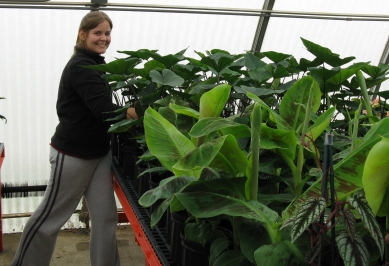
Alicain Carlson of the 2008 class shows off her tropicals grown from tissue culture starts, all ready for the Big Plant Sale. She’s now a graduate student in Horticultural Science at North Carolina State University and hopes to pass all this on to her future students.
Blue Spruce Blues
One of the roles I’ve evolved into over the past decade as an extension specialist at MSU is that of ‘the Conifer Guy’. Conifers are great and fascinating plants. The oldest trees in the world are conifers, the largest trees in the world are conifers, and some of the most interesting (at least to me) landscape plants are conifers. Unfortunately, for a variety of reasons, in the Upper Midwest we have gravitated to Colorado blue spruce more than just about any other conifer. Part of this over-reliance on blue spruce in the landscape is driven by production (see, Linda, I’m not always an apologist for nurseries). Growers want to grow what they know and what’s easy to grow. As a nursery tree, blue spruce is a reliable performer that is well adapted to a relatively wide range of site conditions. Of course, growers also want to grow what they can sell, and there always seems to be a steady demand for blue spruce. In many neighborhoods it appears that there is an ordinance that every other tree has to be a blue spruce. So what’s the issue? In the Great Lakes region, blue spruce often look pretty good when young. However, as trees age they become susceptible to several major pests, especially cytospora canker and gall adelgid. So all those shapely blue Christmas trees that were planted 10 or 15 years ago are now a bunch of ratty-looking messes. So what’s the solution for blue spruce burn-out? Clearly landscapers and homeowners need to think beyond blue spruce and look for a greater variety of choices. Here are three to consider.
– Serbian spruce Picea omorika Whenever I’m asked to suggest a conifer, Serbian spruce is usually one of the first trees in the conversation. While the color may not be as striking as a blue spruce, Serbian spruce still has impressive needles in its own right – bi-color with dark green on the upper side and silver below. Adding to Serbian’s charm is its graceful weeping habit.
– Swiss stone pine Pinus cembra The late, great conifer expert Chub Harper used to remark, “I never met a cembra I didn’t like.” Chub’s fondness for Swiss stone pine was well founded. Here is an understated, consistent landscape performer. Few pests, dark green needles and stately upright form.
– Korean fir Abies koreana It would be a stretch to consider Korean fir an alternative to blue spruce. While Korean fir is more broadly adapted than many of its pantywaist cousins in the genus Abies, it will still do best on the Holy Grail of moist, well-drained slightly acidic soils. Nevertheless, Korean is tougher than the average fir and is a conifer with some character and worth a shot. Korean firs are often heavy cone producers, which can add an interesting element of color.
Friday’s puzzle solved
Here’s Friday’s photo without my edits:
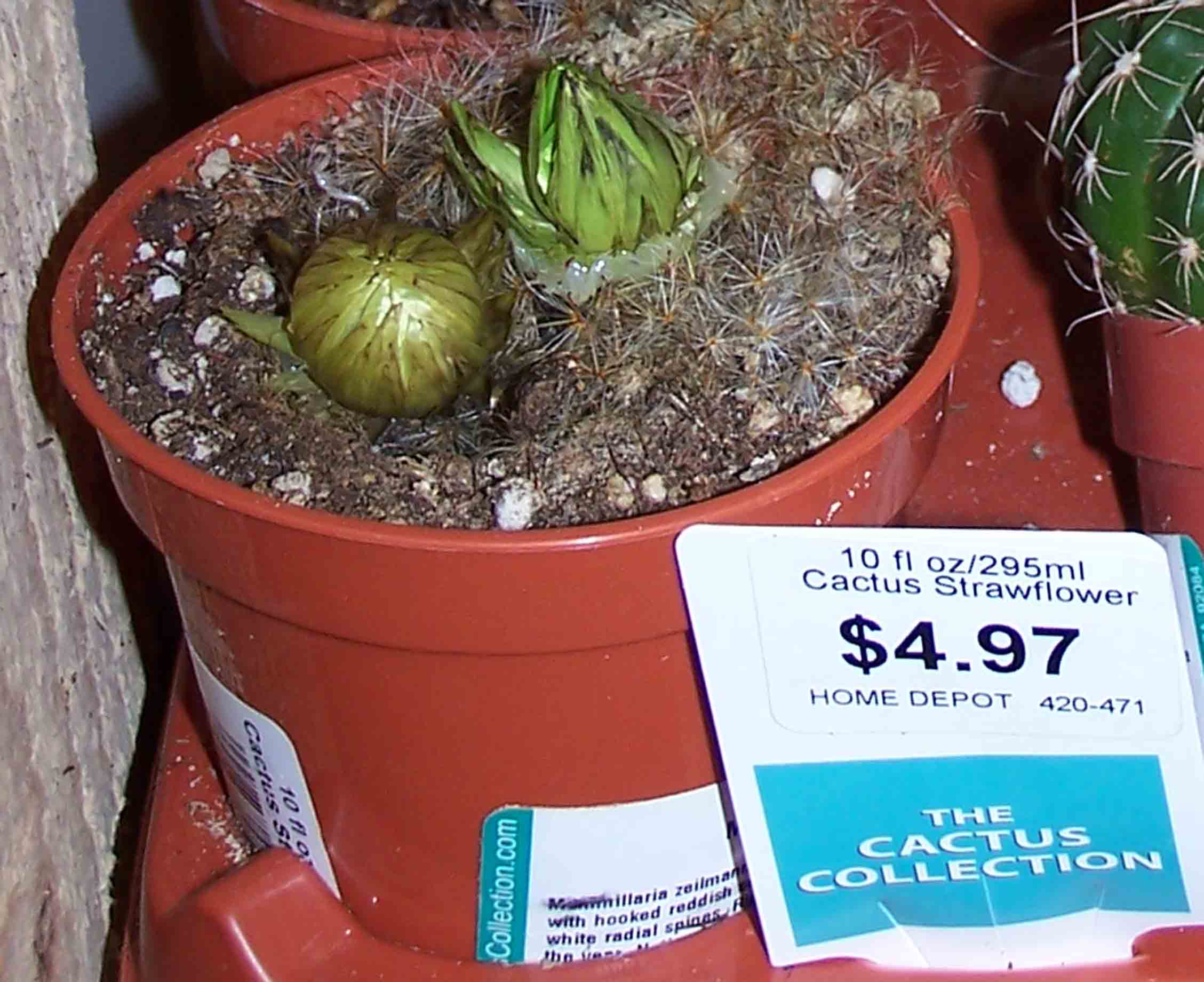
As you can see, there are tell-tale globs of hot glue around the base of the bud on the right. Hap was correct – it’s yet another “cactus strawflower” whose cactus portion had disintegrated, leaving only the strawflower graft behind. But out of context it could easily be mistaken for a bulb of some sort. Let the buyer beware!
Friday fun, part 2
OK, enough tormenting of my fellow GP. On to today’s photo challenge.
Is it a miracle? Is it a resurrection plant? How do you explain these large buds emerging from the soil?
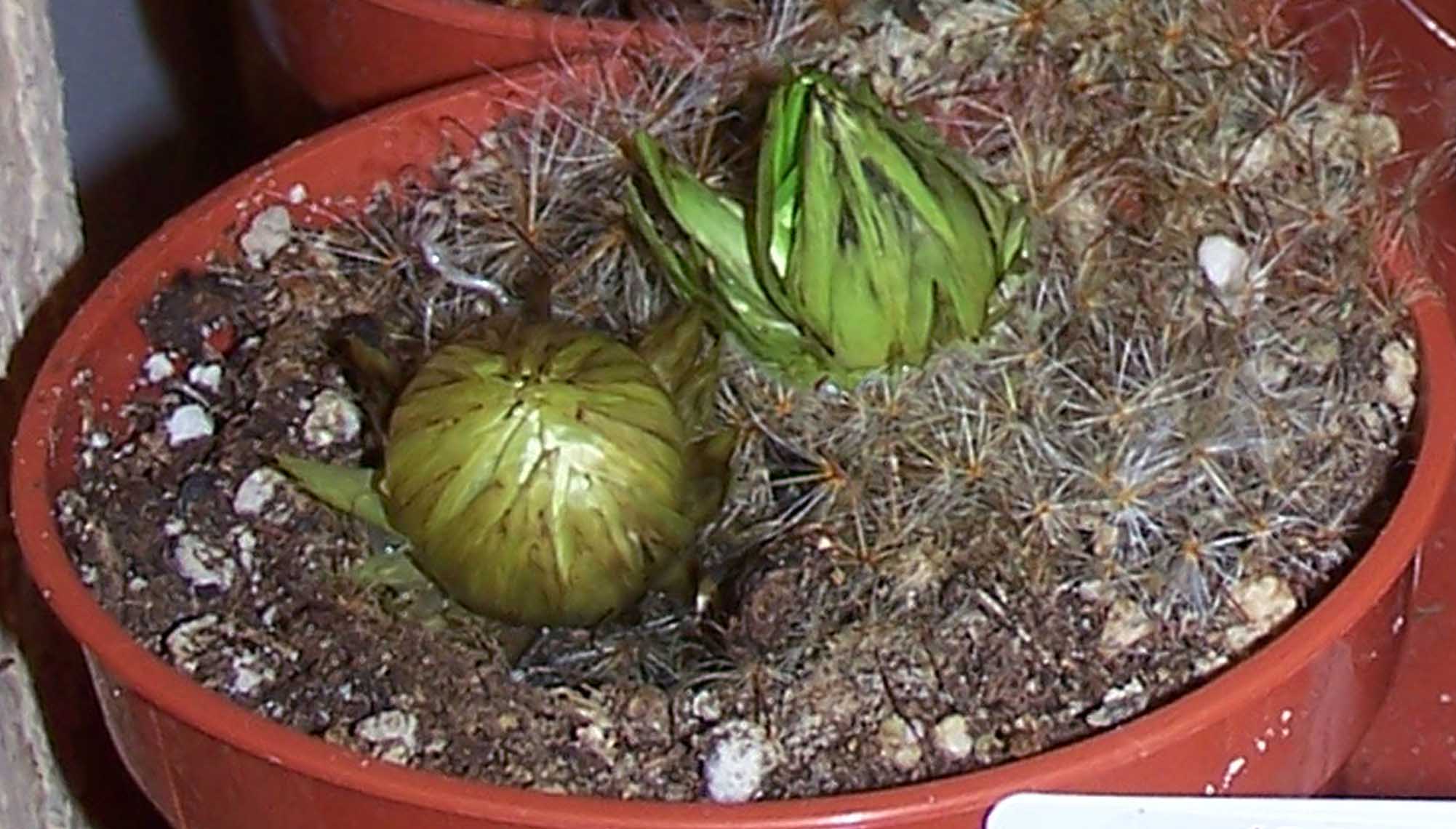
A disclaimer: a portion of this photo has been Photoshopped. I promise the altered area was not of plant material. Monday’s answer will include the untouched photo in bigger context
Friday fun, part 1
This posting is for Holly, who I am sure is desperately trying to finish her annual review. I feel your pain! And I’m going to add to it today.
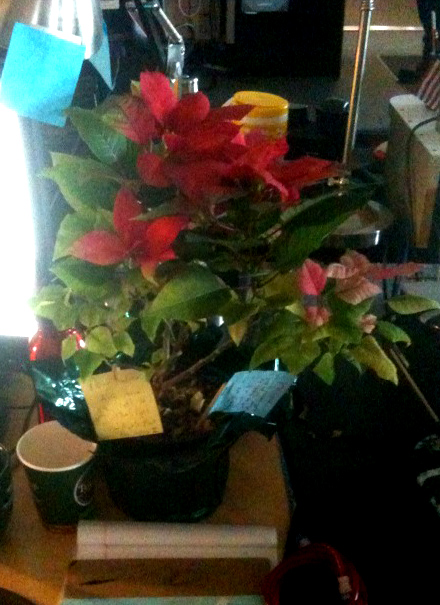

The poinsettia in these photos is not from this Christmas, but from 2008. You can see it thriving happily in its office environment. I’m told by its caretaker Nick (a nongardener) that it has no bugs or other problems, and seems very happy. And it’s blooming, without the benefit of the extended night period. (The post-it notes are instructions to its care when Nick is away.)
Apparently SOME people can easily grow poinsettias well past their expected holiday life span.
Is This Really a Good Idea?
Transgenic plants have been with us for well over a decade now. I have had the opportunity to work with many of the tools used for this technology, though most of that is far behind me (over 15 years now since I “ran a gel”) — I’m much happier being outside or even in front of a computer writing than in a lab. Fortunately I have a number of “lab rat” colleagues so I’m relatively up to date on what’s going on and what “gene-jumper” scientists can and can’t do.
To make a long story short, over these years transgenic plants have proven to be useful in some cases (by reducing the use of certain dangerous pesticides), and concerning in others (because some genes have escaped cultivation). I’m not going to go into the crazy ins and outs of the benefits and drawbacks of genetic engineering here except to give you my general opinion which is that every case needs to be handled individually. I do not believe that this engineering is, in and of itself, a bad thing. That said, I do believe that genetic engineering could get us into trouble if we’re not careful.So, with that little disclaimer I thought I’d mention something that I question — I’m not going to call it bad — but maybe it is. There’s an “artist” at the University of Minnesota — Eduardo Kac, who had some of his genetic material placed into a petunia so that some of the proteins from his body were expressed along with the petunias. I don’t have a picture of the petunia itself, but here on the St. Paul campus of the University of Minnesota you can see this structure, created by Kac, which is a graphic representation of a protein from the petunia.
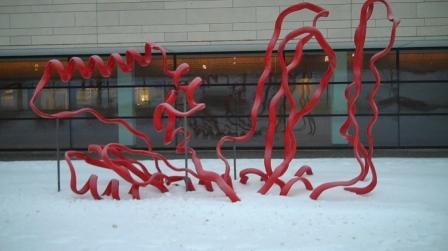
(It was around 20 degrees outside when I took this shot — positively balmy compared to what it’s been like).
Anyway — as I said above — Though I have some concerns, I’m not opposed to using biotechnology for the “good of man.” Nor am I afraid that Kac’s creation is dangerous — from what I know it was kept in a closed system and the petunia was ultimately destroyed — not that it would have been particularly dangerous even if it had been released. But….to me anyway….This seems like a frivolous use of a powerful tool (that tool being the ability to move genes from one organism to another). I don’t know if I’d call it bad….but the words Wasteful and Inappropriate come to mind.
By the way, though I know less about it, it seems that Kac also transferred genes into a rabbit for the sake of art. But this is, after all, a horticulture blog so I thought I’d stick with plants!
Why I dislike rootgrafted plants
I’m pretty much a live-and-let-live person in terms of plant choices (as long as they’re not invasive). But I’m becoming convinced that oddities grafted onto hardy rootstocks are poor choices, because the rootstock always seems to win. I posted one of these several months ago (see October 28, 2009 ), but just today have just found the poster tree for my anti-rootgraft movement.
A little backstory. I’m currently out at the Washington coast, trying to get some writing and seminars done without disruption. Today I had to make a trip into Aberdeen, the horrors of which will have to wait for another post. Before going back to my retreat, I tried to renew my enthusiasm for life by seeking out bad plants. I was well rewarded.

I have to give my daughter Charlotte credit for spotting these lovelies. There were two of these $50 Betula pendula ‘Youngii’ trees available. I felt like I’d stumbled upon the next winner of “America’s Next Top Model.” I took pictures from every angle, full shots and close-ups, for your viewing enjoyment.
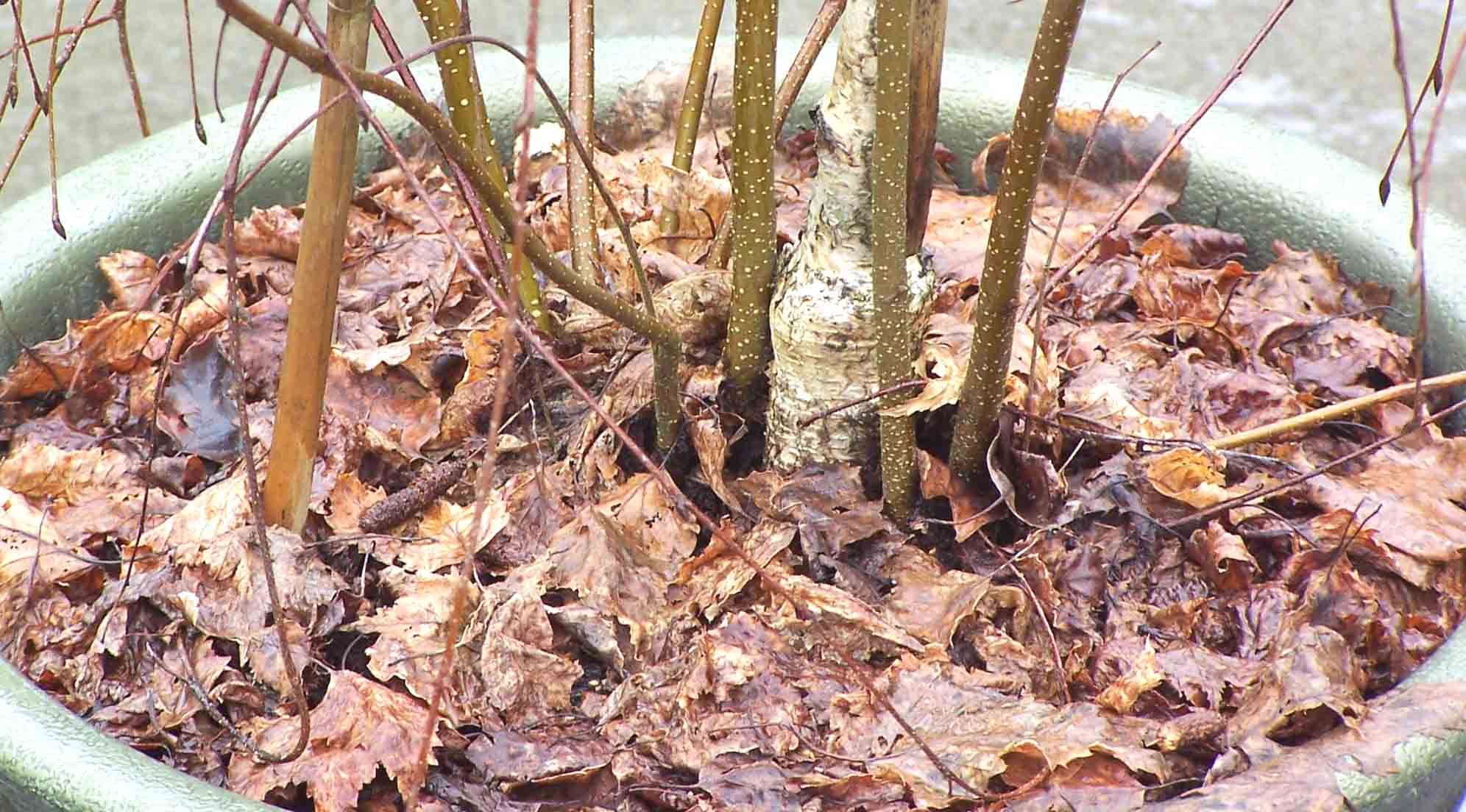
Note that the “unusual deciduous tree with pendulous branches” is a grafted tree, evidenced by the differences in girth at the grafting point. You’ll also note the appearance of vigorous watersprouts emerging from below the graft. (The bamboo stake to the left lost it function years ago, but is still adds an unexpected pop to the overall composition.)

And here she is in her full beauty! The “S” curve of the scion is bisected longitudinally by two watersprouts, forming a giant $! I do have to agree with the tag at this point – it certainly is “an excellent accent or specimen plant” for the Island of Misfit Grafts.
Finally, please enjoy yet a final reason I don’t like grafts:

(Hint: Note the glue glob.)
And now for something completely different…
From this week’s e-mail file…
“Dear Dr. Cregg:
As I’ve done for many year, this year I harvested my “wild” Christmas tree from the Huron-Manistee National Forest. I cut the tree at ground level. Soon after I brought it home, it started sprouting new light green clumps of needles at the tips of many branches. Is the tree actually growing? It doesn’t seem possible that it’s still alive, but it seems to be thriving and I hate to toss the tree to the curb if it’s fighting for life. I am tempted to leave it in the tree stand to see what happens….”
Pat M.
Midland, MI
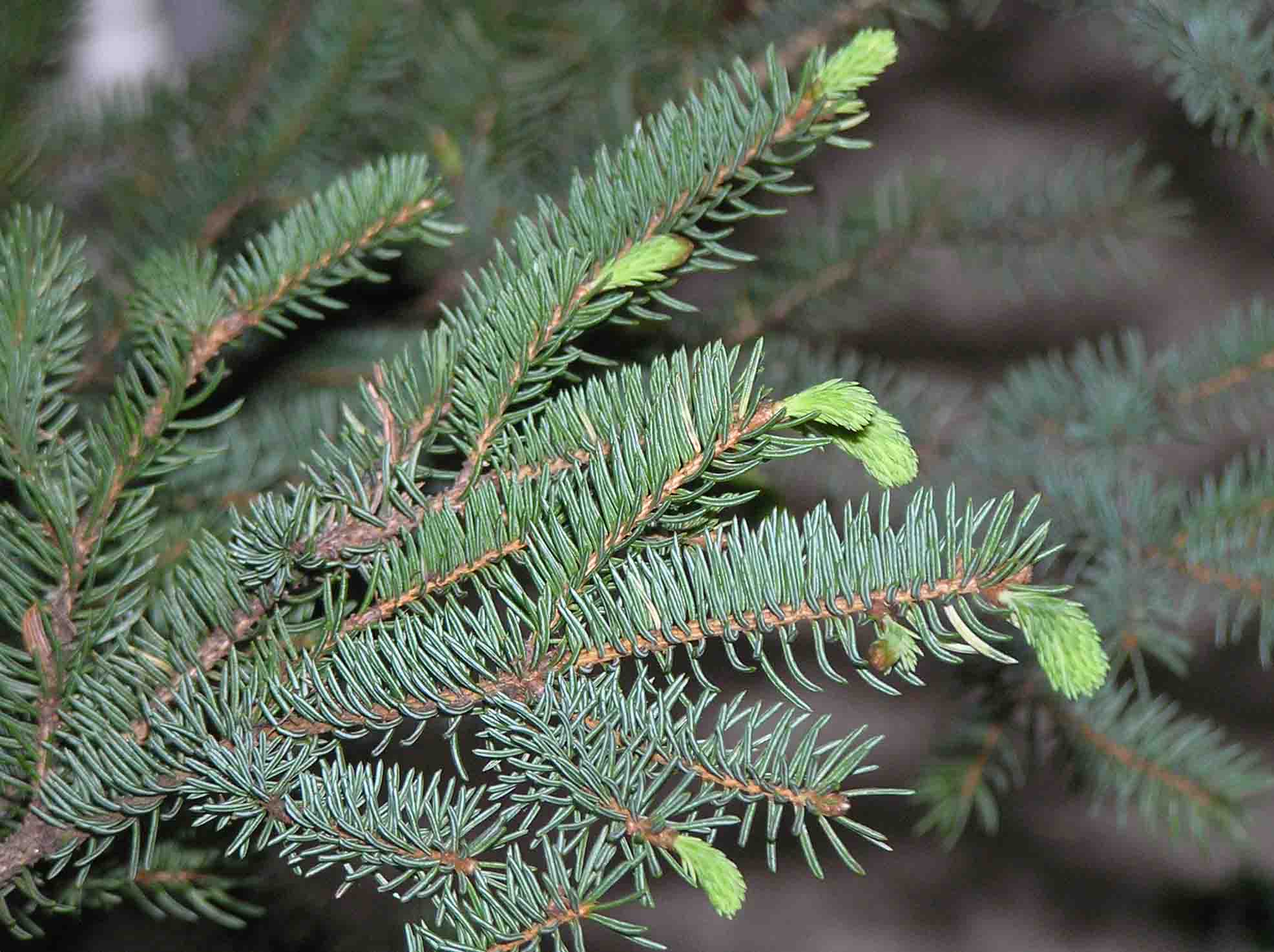
Dear Pat:
The tree is dead, it just doesn’t know it yet. Depending of the species, some Christmas trees will break bud and begin to grow once they are brought indoors. The tree is still alive in the sense that its needles are still carrying out photosynthesis and water is still moving up the trunk to the needles. But since the tree has no roots and no way to produce any new roots, it has no prospect for long-term survival. The phenomenon you’re observing is common in some spruces and other conifers adapted to cold regions. Before you cut the tree, the buds were exposed to enough cold to meet their chilling requirement to overcome dormancy – the only thing that keeps trees in wild from growing at this point are cold temperatures. Once you brought it indoors, the tree ‘thought’ is was spring and started to grow. If you or a family member want to do a little science project you could keep the cut end in water and see how long the tree lasts. Eventually, however, the conducting elements at the cut end will begin to plug with resins and the tree won’t be able to move enough water to meet its needs and will expire.
Regards,
Bert Cregg